"Fabulous Fishes," a hands-on ichthyological extravaganza, was
held May 4, 2002 at the Clinton Community Nature Center in Clinton, Mississippi. Members
of the North American Native Fishes Association and biologists from the U.S. Army Engineer
Research and Development Center at Waterways Experiment Station organized the event and
worked more than a dozen exhibits, experiments, and games. Here are a few photo
highlights.

Stations were set up a week in advance. Each included multiple specimens and
activities, posters, and all offered some kind of handout or brochure representative of
that subject. This is the station set up to demonstrate types of fish scales, how they are
used by the fish and how they are used by fishery biologists. There are gar hides, spiny
boxfish, samples of fish skin, mounted cross-sections of sturgeon spines, and mounted
scales of buffalo and carp. |
|

Neil Douglas, Professor Emeritus of Ichthyology and Herpetology, was one of the
first volunteers to arrive. Here he is preparing preserved specimens for "Name That
Fish," a taxonomic survey of local fishes. |
|

Martin Moore, Mississippi Rep for NANFA, also arrived early to set up aquaria of
native fishes. Martin's exhibit includes tropical fish posters, but the NANFA exhibit is
comfortingly close-by. |
| 
Jan Hoover and Catherine Murphy look over a collection of skulls, skeletons, teeth,
and disarticulated bones. Catherine used these to introduce vistors to fish morphology,
anatomy, and general biology.
|
|

Volunteers prepare to register more than 100 visitors. After name and addresses
were recorded (for prize drawings that day, announcement mailings later in the year), a
card was issued to each visitor. This card was stamped by the experts at different
stations to show the visitor had completed that event. |
|

Faye Dickerson (Dena's mother) issues cards to visitors and demonstrates a
rare talent for ictalurid ventriloquism. |

Neil Douglas exhibits preserved fishes representing all major taxonomic groups of
the lower Mississippi Basin and nearby waters. Body shape, distinctive structures, and
ususual markings useful in identification are explained. |
|
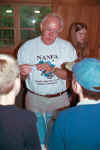
Working with a juvenile specimen, Neil shows two young naturalists how a paddlefish
uses its rostrum.
|
|

The boys, both clearly enthusiasts of sharks and sharklike fishes, examine one of Neil's
darters showing a appreciation for smaller, modern fishes as well. |
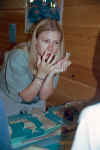
Catherine Murphy emphasizes the complexity and diversity of fish skulls and skull bones. |
|

Differences between heterocercal and homocercal tails of fish are explained by Catherine
and the surpising number of bony rays in a buffalo tail intrigue two young observers.
|
|

No bony structures have the sheer drama of toothy jaws, however. After exhibiting the
nearly smooth jaws of a paddlefish, Catherine shows off the jaws of an unidentified shark,
creating some excitement in the process. |

Dennis Riecke, fishery biologist for the state of Mississippi, invites visitors to handle
samples of sturgeon skin, experience the sharpness of their scutes, and learn for
themselves why these fish are sometimes called hacklebacks. |
|

Resembling mediaeval mace and armor, a dried puffer and a gar hide, allow Dennis to
demonstrate how effectively scales can protect the fish that wear them.
|
|

Sturgeon spines and buffalo scales are tools of the trade for the fishery biologists who
study population biology of riverine fishes. Here Dennis trains two young men on the
methods for counting annular rings. |

An experiment showing the differences in breathing rates of goldfish in cool water and in
warm water, and comparing respiratory behavior with air-breathing bowfin, attracted
onlookers and participants of all ages. |
|

Most of the older kids could count gill beats and record the data for themselves.
|
|

The little ones needed a little help from their parents or from the high school
volunteers, but even they were able to see (and sometimes act out) the differences in
breathing rates and behavior among the fish. |
| 
These fish heads were mummified by Steven George and used at the feeding
biology station to illustrate the morphological traits of predators feeding on different
types of prey.
|
|

Here, Jessica, a high school volunteer shows a young visitor how to analyze mouth size and
position, gill raker length and spacing, pharyngeal tooth structure, tooth and eye size to
infer types of foods eaten.
|
|

Visitors to the feeding station were also allowed to select a preserved
fish stomach from those of five different species. Jessica and Jan instructed the budding
fish dieticians on dissection and prey identification.
|
| 
Bradley Lewis operates a station featuring exhibits and activities related to fishing and
collecting gear. Here Bradley demonstrates proper casting technique. A hoopnet used to
sample small rivers is nearby.
|
|
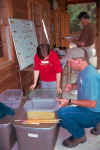
Selectivity of different mesh sizes was demonstrated using a mixture of of different types
of beans and rice, and mini-seines.
|
|
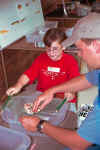
Bradley shows a young vistor how larger species are retained by this seine while the
smaller species pass through.
|

The taxonomic skills of Austin George (Steven's son) are tested by Bradley (Steven's
co-worker) using magnetic fishes and a metal white-board. Austin, by the way, passed with
flying colors. |
|

Martin Moore sets up his "How to Set Up an Aquarium" display.
|
|
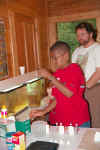 
Chemistry can be fun...when you have samples from native fish aquaria with water quality
test kits. Martin looks on as youngsters evaluate pH and nitrates from Martin's display
tanks of shiners.
|

Test tubes and colored water are great but nothing gets the attention of a young
ichthyologist like ganoid fishes. Here, one of the regulars at the Nature Center's
outreach programs watches a gar for a very long time. |
|

This is the NANFA display. It consists of Charlie Nunziata's title and background
poster, an original poster describing the fishes of Mississippi that were emphaszied at
Fabulous Fishes (ganoids, suckers, darters), and a poster describing how American Currents
could be used as a classroom resource. With the poster are stacks of AC articles that can
be used as instructional materials in biology and in geography, political science, and
American history. Also available are NANFA information and grant brochures, membership
applications, and some miscellaneous freebies (reprints of a book chapter on wetland
fishes, Topeka shiner trading cards). |

Martin lures a woman away from the aquaria and towards the NANFA display. Unfortunately,
he was unable to reel her in as a new member. |
|
  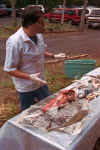
Steven George, the "Dissecting Machine," deconstructs a shark, spoonbill,
shovelnose sturgeon, spotted sucker, and a largemouth bass. Visitors receive an animated
three-hour course in Comparative Anatomy topics unlikely to be addressed in most college
curricula.
|

Steven continues to dissect fish in the pouring rain while most onlookers marvel at his
stamina and one signals to "Please Send Help." |
|
   
The Explorations Table is loaded with taxodermic and preserved specimens, fish bones,
books, and other durable items. The alligator gar skull is a real attention-getter, but so
are...Shark-Jaws and View-Masters!
|
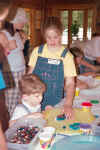 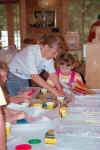
Clay, fish-shaped cookie-cutters, sequins, and other odd-and-ends allow kids to make
models of some fishes they see or would like to see. |
|
 
The mysterious Grotesquerie - where visitors can observe, close-up, fishes that dare to
violate the Laws of Nature! Dennis describes, as visitors see for themselves, wonders like
the shovelnoseless sturgeon, the black-and-white one-eyed blue catfish, and the
smallest-mouth buffalo.
|
| 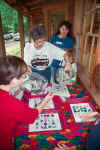
Fish Bingo - where every player is a winner and every winner is the proud recipient of a
candy-skulled, plastic fish skeleton. Shirley Douglas passes out prizes to excited
contestants.
|
|

Gyotaku - the age-old Japanese art of fish printing. Plastic models and readily available
paint sets allowed adults and kids the opportunity to make linen prints of their favorite
fish. Nine species were offered (two were non-native) allowing gyotaku artists the chance
to print fishes of various shapes in the color of their choice.
|
| 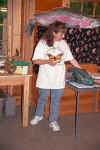

Fabulous Gifts for Fabulous Fish Participants - Dena Dickerson draws names of
visitors and awards a variety of piscatorial prizes including books, aquarium nets, rubber
sharks, and an amazing variety of glass paperweights, plant pots, pens, aquarium nets,
inflatable rafts, and flashlights all shaped like fishes! Dena came up with the idea for
Fabulous Fishes, organized more than 30 volunteers and 15 exhibits and activities, created
the fishing and taxonomic games, made educational handouts, organized specimens, acted as
MC during the big day and took many of these photographs. She made Fabulous Fishes happen
and made it a success for the more than 150 people that took part.
|
| 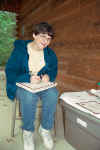
Graduation - Carol Baird fills out diplomas documenting that visitors successfully
completed the Fabulous Fishes program and are certified as Junior Ichthyologists. These
were given out to visitors who participated in activities at Name That Fish, Fish
Breathing, Fish Bones, and Scales and Age stations. Along with the certificates, visitors
received fossilized shark and ray teeth, and environmentally-themed bookmarks, bookcovers,
coloring-pages, and drinking cups.
|















































